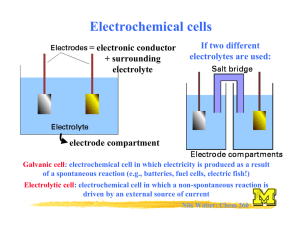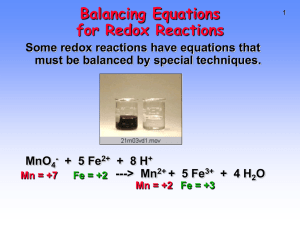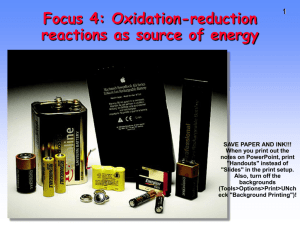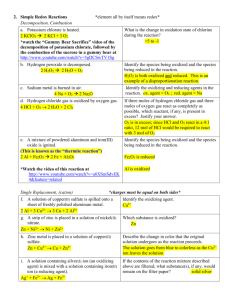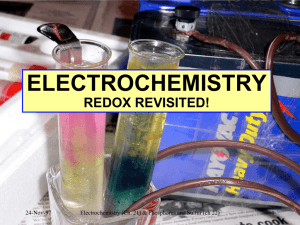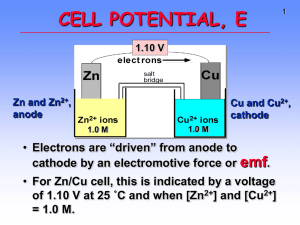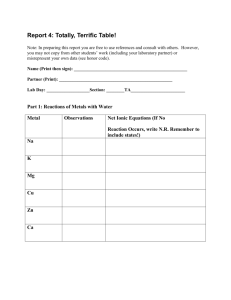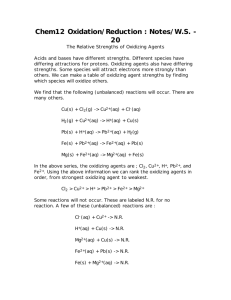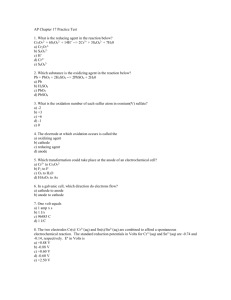Unit 6 Lecture 1 Redox and E
advertisement
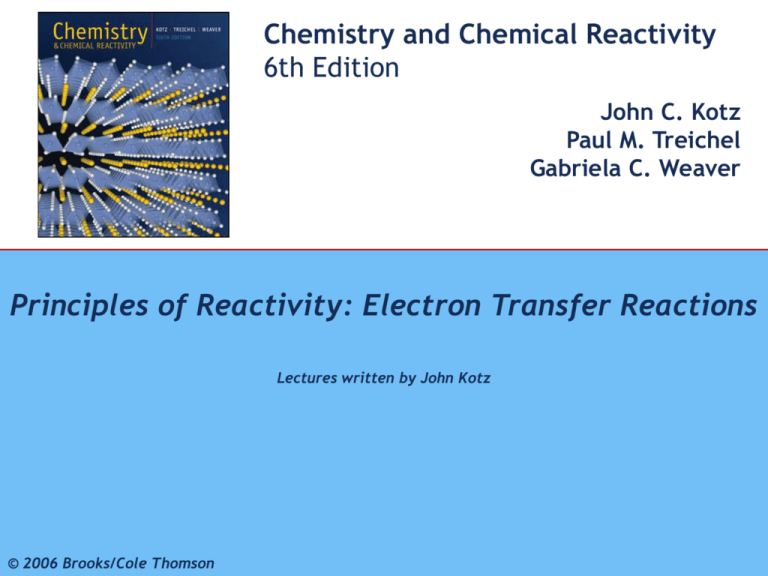
Chemistry and Chemical Reactivity 6th Edition John C. Kotz Paul M. Treichel Gabriela C. Weaver Principles of Reactivity: Electron Transfer Reactions Lectures written by John Kotz © 2006 Brooks/Cole Thomson ELECTROCHEMISTRY Chapter 19 TRANSFER REACTIONS Atom/Group transfer HCl + H2O ---> Cl- + H3O+ Electron transfer Cu(s) + 2 Ag+(aq) ---> Cu2+(aq) + 2 Ag(s) Electron Transfer Reactions • Electron transfer reactions are oxidation-reduction or redox reactions. • Redox reactions can result in the generation of an electric current or be caused by imposing an electric current. • Therefore, this field of chemistry is often called ELECTROCHEMISTRY. Review of Terminology for Redox Reactions • OXIDATION—loss of electron(s) by a species; increase in oxidation number. • REDUCTION—gain of electron(s); decrease in oxidation number. • OXIDIZING AGENT—electron acceptor; species is reduced. • REDUCING AGENT—electron donor; species is oxidized. OXIDATION-REDUCTION REACTIONS Direct Redox Reaction Oxidizing and reducing agents in direct contact. Cu(s) + 2 Ag+(aq) ---> Cu2+(aq) + 2 Ag(s) Balancing Equations Cu + Ag+ --give--> Cu2+ + Ag Balancing Equations Step 1: Divide the reaction into half-reactions, one for oxidation and the other for reduction. Ox Cu ---> Cu2+ Red Ag+ ---> Ag Step 2: Balance each for mass. Already done in this case. Step 3: Balance each half-reaction for charge by adding electrons. Ox Cu ---> Cu2+ + 2eRed Ag+ + e- ---> Ag Balancing Equations Step 4: Multiply each half-reaction by a factor so that the reducing agent supplies as many electrons as the oxidizing agent requires. Reducing agent Cu ---> Cu2+ + 2eOxidizing agent 2 Ag+ + 2 e- ---> 2 Ag Step 5: Add half-reactions to give the overall equation. Cu + 2 Ag+ ---> Cu2+ + 2Ag The equation is now balanced for both charge and mass. Balancing Equations for Redox Reactions Some redox reactions have equations that must be balanced by special techniques. MnO4- + 5 Fe2+ + 8 H+---> Mn2+ + 5 Fe3+ + 4 H2O Mn = +7 Fe = +2 Mn = +2 Fe = +3 Reduction of VO2 with Zn + Balancing Equations Balance the following in acid solution— VO2+ + Zn ---> VO2+ + Zn2+ Step 1: Write the half-reactions Ox Zn ---> Zn2+ Red VO2+ ---> VO2+ Step 2: Balance each half-reaction for mass. Ox Zn ---> Zn2+ + + VO + ---> VO2+ + H O 2 H 2 2 Red Add H2O on O-deficient side and add H+ on other side for H-balance. Balancing Equations Step 3: Balance half-reactions for charge. Ox Zn ---> Zn2+ + 2eRed e- + 2 H+ + VO2+ ---> VO2+ + H2O Step 4: Multiply by an appropriate factor. Ox Zn ---> Zn2+ + 2eRed 2e- + 4 H+ + 2 VO2+ ---> 2 VO2+ + 2 H2O Step 5: Add balanced half-reactions Zn + 4 H+ + 2 VO2+ ---> Zn2+ + 2 VO2+ + 2 H2O Tips on Balancing Equations • Never add O2, O atoms, or O2to balance oxygen ONLY add H2O or OH-. • Never add H2 or H atoms to balance hydrogen ONLY add H+ or H2O. • Be sure to write the correct charges on all the ions. • Check your work at the end to make sure mass and charge are balanced. • PRACTICE! Best oxidizing agents Figure 20.14 Best reducing agents Potential Ladder for Reduction Half-Reactions TABLE OF STANDARD REDUCTION POTENTIALS oxidizing ability of ion Eo (V) Cu2+ + 2e- Cu +0.34 2 H+ + 2e- H2 0.00 Zn2+ + 2e- Zn -0.76 reducing ability of element Using Standard Potentials, Eo Table 20.1 • Which is the best oxidizing agent: O2, H2O2, or Cl2? _________________ • Which is the best reducing agent: Hg, Al, or Sn? ____________________ Standard Redox Potentials, Eo Any substance on the right will reduce any substance higher than it on the left. • Zn can reduce H+ and Cu2+. • H2 can reduce Cu2+ but not Zn2+ • Cu cannot reduce H+ or Zn2+. Standard Redox Potentials, Eo Ox. agent Cu2+ + 2e- --> Cu +0.34 2 H+ + 2e- --> H2 0.00 Zn2+ + 2e- --> Zn -0.76 Red. agent Any substance on the right will reduce any substance higher than it on the left. Northwest-southeast rule: product-favored reactions occur between • reducing agent at southeast corner • oxidizing agent at northwest corner CELL POTENTIALS, Eo Can’t measure 1/2 reaction Eo directly. Therefore, measure it relative to a STANDARD HYDROGEN CELL 2 H+(aq, 1 M) + 2e- <----> H2(g, 1 atm) Eo = 0.0 V Calculating Cell Voltage • Balanced half-reactions can be added together to get overall, balanced equation. Zn(s) ---> Zn2+(aq) + 2eCu2+(aq) + 2e- ---> Cu(s) -------------------------------------------Cu2+(aq) + Zn(s) ---> Zn2+(aq) + Cu(s) If we know Eo for each half-reaction, we could get Eo for net reaction. Uses of Eo Values Organize half-reactions by relative ability to act as oxidizing agents • Use this to predict direction of redox reactions and cell potentials. Cu2+(aq) + 2e- ---> Cu(s) Zn2+(aq) + 2e- ---> Zn(s) Eo = +0.34 V Eo = –0.76 V Note that when a reaction is reversed the sign of E˚ is reversed! Using Standard Potentials, Eo • In which direction do the following reactions go? • Cu(s) + 2 Ag+(aq) ---> Cu2+(aq) + 2 Ag(s) – Goes right as written • 2 Fe2+(aq) + Sn2+(aq) ---> 2 Fe3+(aq) + Sn(s) – Goes LEFT opposite to direction written • What is Eonet for the overall reaction? Eo and Thermodynamics • Eo is related to ∆Go, the free energy change for the reaction. • ∆G˚ is proportional to –nE˚ ∆Go = -nFEo where F = Faraday constant = 9.6485 x 104 J/V•mol of e(or 9.6485 x 104 coulombs/mol) and n is the number of moles of electrons transferred Eo and ∆Go ∆Go = - n F Eo For a product-favored reaction Reactants ----> Products ∆Go < 0 and so Eo > 0 Eo is positive For a reactant-favored reaction Reactants <---- Products ∆Go > 0 and so Eo < 0 Eo is negative Eo and Equilibrium Constant DGo = -RT ln K DGo = -nFEo

